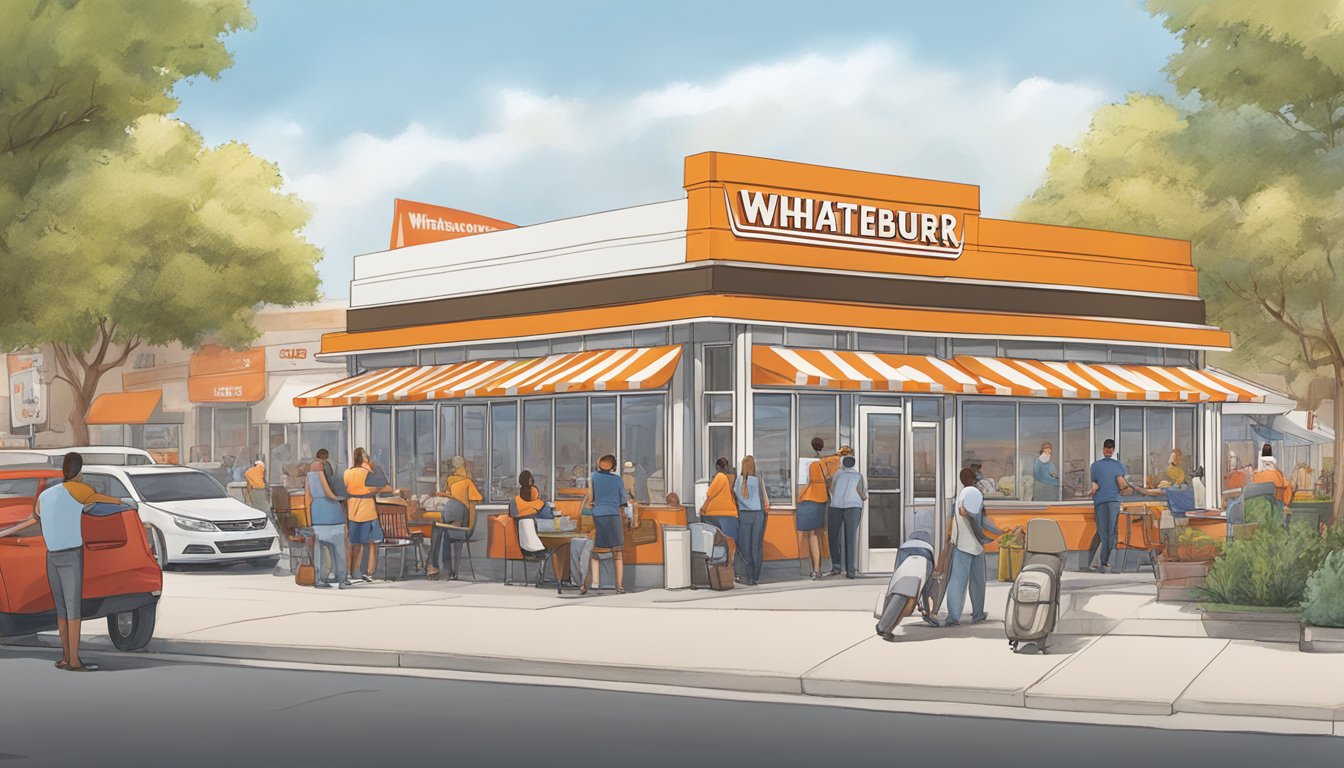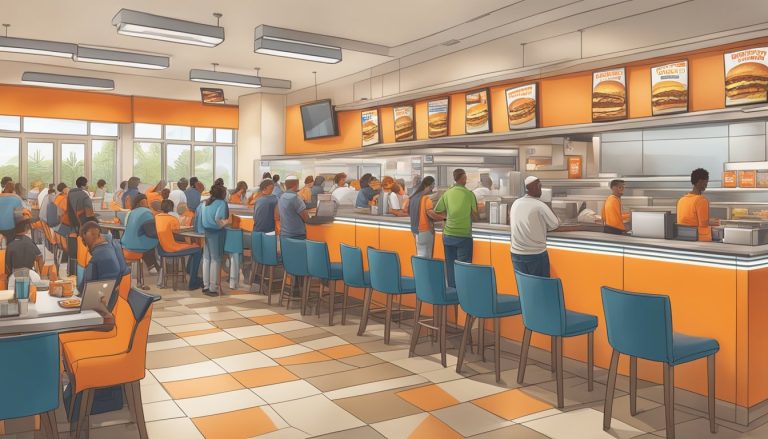Whataburger, the iconic Texas fast-food chain, has become more than just a place to grab a quick meal. Its impact extends far beyond satisfying hunger, particularly when it comes to breakfast and local economies. The company’s decision to serve breakfast from 11 p.m. to 11 a.m. caters to a wide range of customers, from night shift workers to early risers.
Whataburger’s expansion has brought substantial economic benefits to local communities through job creation, tax contributions, and support for local businesses. As the chain grows, it hires local residents for various positions, from entry-level to management roles. This job creation helps stimulate local economies and provides opportunities for career growth within the company.
Beyond employment, Whataburger takes its role as a corporate citizen seriously. The company has implemented various initiatives to give back to communities across Texas and beyond. One key program, Feeding Student Success, demonstrates Whataburger’s commitment to supporting education and addressing food insecurity among students.
History and Growth of Whataburger
Whataburger’s journey from a small Corpus Christi burger stand to a beloved regional icon spans over seven decades. The company’s expansion reflects its deep Texas roots and commitment to quality.
The Journey from a Single Burger Stand
Harmon Dobson founded Whataburger in Corpus Christi, Texas, on August 8, 1950. His vision was to create a burger so big it required two hands to hold. The first Whataburger sold for 25 cents, and the restaurant’s popularity grew quickly.
By 1960, Whataburger had expanded to 17 locations. In 1961, the company introduced its iconic orange and white striped A-frame buildings, starting in Odessa, Texas. This distinctive design became a hallmark of the brand.
Whataburger continued to innovate, adding new menu items like the Breakfast On A Bun and Whatachick’n sandwich. The company’s growth accelerated, and it became a treasured part of Texas culture.
Acquisition by BDT Capital Partners and Expansion
In 2019, BDT Capital Partners acquired a majority stake in Whataburger. This move marked a significant shift in the company’s ownership structure.
The acquisition aimed to drive Whataburger’s expansion beyond its traditional markets. BDT Capital Partners brought additional resources and expertise to support growth strategies.
Whataburger moved its headquarters to San Antonio, signaling a new era for the company. The leadership team focused on maintaining the brand’s core values while pursuing aggressive expansion plans.
Franchising and Market Penetration
Whataburger’s franchising model has been key to its growth and market penetration. The company carefully selects franchise partners who share its commitment to quality and customer service.
Each new Whataburger restaurant typically employs 50-100 workers, contributing to local job creation. This approach has helped the brand maintain strong community ties as it expands.
Whataburger has successfully entered new markets while retaining its Texas-based identity. The company’s expansion strategy balances growth with preserving its unique culture and traditions.
Economic Influence on Local Communities
Whataburger’s presence extends beyond serving tasty breakfast items. The fast-food chain plays a significant role in shaping local economies and communities across Texas and beyond.
Job Creation and Regional Businesses
Whataburger stands as a major employer in many Texas cities. The company’s expansion has led to the creation of numerous job opportunities, from entry-level positions to management roles. This employment boost contributes to reduced unemployment rates and increased disposable income for local residents.
Whataburger’s growth strategy has influenced regional business dynamics. As new locations open, they often attract other businesses to the area, creating small commercial hubs. This clustering effect can revitalize neighborhoods and spur further economic development.
The chain’s success has also inspired local entrepreneurs. Many former Whataburger employees have gone on to start their own businesses, applying the skills and experience gained from working at the restaurant.
Supporting Local Suppliers and Fresh Ingredients
Whataburger’s commitment to quality extends to its supply chain. The company prioritizes partnerships with local suppliers, particularly for fresh ingredients. This practice supports regional agricultural businesses and food producers.
By sourcing locally, Whataburger helps:
- Reduce transportation costs and carbon footprint
- Ensure fresher ingredients for customers
- Stimulate local agricultural economies
These partnerships create a ripple effect, indirectly supporting jobs in farming, food processing, and distribution sectors. The emphasis on fresh, local ingredients also aligns with growing consumer preferences for sustainably sourced food.
Community Engagement and Social Responsibility
Whataburger actively engages with the communities it serves. The company’s charitable initiatives focus on education, hunger relief, and disaster response. In 2025, Whataburger expanded its efforts to combat student hunger in Texas.
Key community engagement activities include:
- Sponsoring local sports teams and events
- Hosting fundraisers for schools and non-profits
- Providing meals during natural disasters
These efforts strengthen Whataburger’s bond with local communities, fostering customer loyalty and enhancing its brand reputation. The company’s social responsibility initiatives also help address pressing community needs, complementing public sector efforts.
Whataburger’s Breakfast Menu and Customer Experience

Whataburger’s breakfast offerings combine diverse options, quality ingredients, and customization to create a memorable dining experience. The menu caters to various tastes while emphasizing customer satisfaction through attentive service.
Diverse and Unique Breakfast Offerings
Whataburger’s breakfast menu features a range of items to suit different preferences. The Honey Butter Chicken Biscuit stands out as a popular choice, blending savory and sweet flavors. Breakfast on a Bun provides a classic option starting at $1.05, offering affordability for budget-conscious customers.
Taquitos add a Tex-Mex twist to the morning lineup. The menu also includes heartier options like the Breakfast Burger for $5.39, catering to those with larger appetites.
Biscuit sandwiches and pancake platters round out the selection, ensuring variety for regular patrons.
Quality, Customization, and the Dining Experience
Whataburger emphasizes quality ingredients and cooking methods in its breakfast items. Customers can customize their orders, allowing for personalized meals that meet individual preferences.
The restaurant’s commitment to freshness is evident in its made-to-order approach. This attention to detail contributes to a dining experience that feels more like a home-cooked meal than fast food.
Whataburger’s breakfast menu balances affordability with quality, offering options from simple biscuits to full meal platters.
Customer Service and Satisfaction
Whataburger’s focus on customer service plays a significant role in breakfast satisfaction. Staff members are trained to be attentive and responsive to customer needs.
The chain’s app and rewards program offer exclusive promotions, enhancing value for regular customers. These digital tools also streamline the ordering process, reducing wait times during busy breakfast hours.
Customer loyalty is cultivated through consistent quality and service. Positive experiences with breakfast items and staff interactions contribute to repeat visits and word-of-mouth recommendations.
Cultural and Brand Impact

Whataburger has become deeply ingrained in Texas culture, transcending its role as a fast-food chain. The company’s distinctive identity and marketing strategies have fostered strong regional loyalty and pride.
Symbol of Texas Fast-Food and Texan Cuisine
Whataburger represents more than just burgers; it embodies Texan cuisine and culture. The chain’s menu features iconic items like the Honey Butter Chicken Biscuit, which has achieved cult status among fans. Whataburger’s commitment to large portions and bold flavors aligns with the “everything’s bigger in Texas” mentality.
The restaurant’s 24-hour service caters to the diverse schedules of Texans, from night shift workers to late-night revelers. This accessibility has made Whataburger a reliable fixture in many communities.
Local artists and musicians often reference Whataburger in their work, further cementing its place in Texas popular culture. The brand has inspired everything from fan tattoos to viral memes, demonstrating its cultural significance beyond food.
Strong Brand Identity and Regional Pride
Whataburger’s orange-and-white striped buildings serve as easily recognizable landmarks across Texas and beyond. This distinctive architectural style has become synonymous with the brand, evoking nostalgia and comfort for many Texans.
The company’s slogan, “Just like you like it,” emphasizes customization and personal preference, resonating with the independent spirit of Texas. Whataburger’s long-standing presence in the state has led many Texans to view it as a source of regional pride.
Community involvement plays a crucial role in strengthening Whataburger’s brand identity. The chain frequently sponsors local events and sports teams, fostering goodwill and deepening its connection with customers.
Marketing Strategies and Social Media Presence
Whataburger’s marketing emphasizes its Texas roots and commitment to quality. The company often highlights its use of 100% pure American beef and fresh ingredients, appealing to consumers’ desire for transparency and authenticity.
Social media plays a significant role in Whataburger’s marketing strategy. The brand maintains an active presence on platforms like Twitter and Instagram, engaging with customers through witty posts and timely responses.
User-generated content forms a key part of Whataburger’s social media approach. The company encourages customers to share their Whataburger experiences, amplifying brand loyalty and creating a sense of community among fans.
Whataburger also leverages limited-time offers and seasonal menu items to generate buzz and drive traffic. These promotions often tap into regional preferences and cultural events, further strengthening the brand’s Texas identity.
Sustainability and Corporate Values

Whataburger’s commitment to sustainability and corporate values shapes its business practices and community impact. The company balances environmental stewardship, family-owned traditions, and technological advancements to create a positive influence on local economies and employees.
Environmental Stewardship and Supply Chain
Whataburger prioritizes sustainability through its supply chain management and environmental initiatives. The company partners with local suppliers to reduce transportation costs and carbon emissions. This strategy supports regional economies while maintaining consistent quality across locations.
Whataburger has invested in modern warehouses in San Antonio, Dallas, Phoenix, Houston, and Atlanta. These facilities ensure a farm-to-table supply chain, uncommon in fast food. The company’s focus on fresh ingredients extends to its signature 100% fresh, never-frozen American beef.
To minimize environmental impact, Whataburger implements energy-efficient practices in its restaurants. LED lighting, water-saving fixtures, and recycling programs are standard in many locations.
Core Values and Family Ownership
Whataburger’s core values stem from its family-owned heritage. The company emphasizes quality, customer service, and community involvement. These principles guide decision-making at all levels of the organization.
CEO Ed Nelson and former CEO Preston Atkinson have reinforced Whataburger’s commitment to its roots. Despite growth, the company maintains a family-oriented culture. This approach fosters loyalty among employees and customers alike.
Whataburger actively supports local communities through charitable initiatives. The company contributes to education, health, and disaster relief programs in areas where it operates.
Employee Development and Technological Integration
Whataburger invests in employee growth and technological advancements. The company offers training programs to help staff develop skills and advance their careers. This focus on professional development contributes to job satisfaction and retention.
Technology plays a crucial role in Whataburger’s operations. The company has implemented digital ordering systems and mobile apps to enhance customer experience. These innovations improve efficiency and adapt to changing consumer preferences.
Whataburger also uses technology to optimize its supply chain. Advanced inventory management systems ensure fresh ingredients are always available. This integration of technology supports the company’s commitment to quality and sustainability.
The Future of Whataburger

Whataburger is poised for significant growth and innovation in the coming years. The iconic Texas-based chain has ambitious plans to expand its footprint, revamp its menu offerings, and strengthen its community ties.
Exploring Expansion Plans and New Markets
Whataburger aims to extend its reach beyond its traditional Southern stronghold. The company has set its sights on new markets in Arizona, Florida, Kansas, and Tennessee. This strategic expansion will introduce the beloved brand to millions of potential customers.
Whataburger’s real estate team is carefully selecting prime locations for new restaurants. The company plans to open dozens of new outlets annually, focusing on areas with strong population growth and favorable demographics.
To support this expansion, Whataburger is investing in distribution networks and supply chain infrastructure. This will ensure consistent quality across all locations as the brand grows.
Innovation in Menu and Restaurant Design
Whataburger is committed to evolving its menu while staying true to its roots. The chain plans to introduce new burger variations and side dishes to cater to changing consumer tastes. Healthier options and plant-based alternatives are also in development.
The company is experimenting with new restaurant designs to enhance the dining experience. These include:
- Drive-thru only locations
- Smaller footprint stores for urban areas
- Updated interiors with modern aesthetics
Digital ordering and loyalty programs will play a larger role in Whataburger’s future. The chain is developing a mobile app to streamline ordering and offer personalized promotions.
Leadership Vision and Community Investment
Whataburger’s leadership team is focused on maintaining the company’s family-oriented culture while driving growth. The new CEO, Debbie Stroud, brings fresh perspectives while respecting the brand’s heritage.
Community involvement remains a cornerstone of Whataburger’s strategy. The company plans to:
- Expand its scholarship programs for employees
- Increase partnerships with local schools and youth organizations
- Launch new initiatives to support food banks and disaster relief efforts
Whataburger aims to balance its expansion goals with a commitment to sustainable practices. This includes sourcing more ingredients locally and reducing environmental impact across operations.




